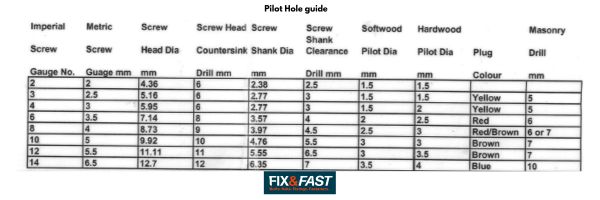How to Determine Pilot Hole Size
Pilot holes are a crucial aspect of woodworking, metalworking, and various other construction projects.
They ensure that screws or nails are inserted accurately and securely whilst preventing damage to the material being worked on.
However, determining the right size for a pilot hole can be a perplexing task for many DIY enthusiasts and professionals alike. In this blog, we'll delve into the intricacies of pilot hole sizing and provide you with a comprehensive approach to determining the perfect pilot hole size for your project.

Why use a Pilot Hole?
Before we look at how you determine pilot hole sizes, let's first understand what a pilot hole is and why it's essential. A pilot hole is a small-diameter hole drilled into a material before driving a screw or nail into it. It serves several purposes:
Preventing Splitting:
Pilot holes help prevent wood from splitting when screws or nails are driven into them. Without a pilot hole, the screw or nail can exert excessive force on the wood fibers, causing them to split.
Accurate Placement:
Pilot holes ensure that screws or nails are inserted precisely where intended, reducing the chances of misalignment or crooked fastening.
Reducing Friction:
By creating a path for the screw or nail, pilot holes reduce the friction encountered during insertion, making it easier to drive them into the material.
Now that we understand the importance of pilot holes, let's explore how to determine the appropriate size for them.
Factors Influencing Pilot Hole Size
Several factors influence the size of the pilot hole required for a particular project:
Material Type:
The type of material you're working with significantly impacts the pilot hole size. For example, hardwoods like oak or maple require larger pilot holes than softwoods like pine or cedar.
Screw or Nail Diameter:
The diameter of the screw or nail you intend to use dictates the size of the pilot hole. A pilot hole should be slightly smaller than the diameter of the screw or nail to ensure a snug fit.
Length of Fixing or Fastener:
Longer screws or nails may require larger pilot holes to accommodate their length and prevent splitting.
Desired Holding Strength:
Depending on the application, you may need to adjust the pilot hole size to achieve the desired holding strength. Some believe a tighter fit provides better grip, but it does increase the risk of splitting.

Determining Pilot Hole Size
Now, let's walk through the steps to determine the appropriate pilot hole size for your project:
Identify Material Type:
Determine the type of material you'll be working with (e.g., hardwood, softwood, metal).
Measure Screw or Nail Diameter:
Use callipers or a measuring tape to accurately determine the diameter of the screw or nail you'll be using.
Consult Reference Charts:
Many reference charts and online calculators provide guidelines for pilot hole sizes based on screw or nail diameter and material type. These charts are invaluable resources for quickly determining the appropriate pilot hole size. The one below is what our trade counter team use to advise customers. As seen with #askaidy on TikTok

Consider Depth: Determine the depth of the pilot hole based on the length of the screw or nail. The pilot hole should be slightly deeper than the length of the fastener to ensure proper engagement.
Test and Adjust: Before drilling all pilot holes, it's advisable to test the size on a scrap piece of material to ensure it provides the desired fit and holding strength. If necessary, adjust the pilot hole size accordingly.
Where to Get Advice on Fixings and Fasteners
Mastering the art of determining pilot hole sizes is essential for achieving professional results in woodworking, metalworking, and construction projects.
By considering factors such as material type, screw or nail diameter, and desired holding strength, you can accurately determine the appropriate pilot hole size for your specific application.
Remember to consult reference charts and test sizes on scrap material first. Making adjustments as needed to ensure optimal performance. With practice and attention to detail, you'll become adept at selecting the perfect pilot hole size for any project.
For further pilot hole advice, and support with general fixing enquiries contact one of our team at Fix and Fast.
You can call us and speak to a real person on 01482 324731 or you can email us at sales@fixandfast.co.uk
At Fix and Fast you can find everything you need to drill the perfect pilot hole with a range of drill bits and screws








